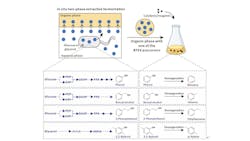Researchers Develop Renewable Route to Petrochemical Aromatics
Researchers at the Korea Advanced Institute of Science and Technology (KAIST) have developed an integrated chemobiological process that converts renewable carbon sources such as glucose and glycerol into benzene, toluene, ethylbenzene, and p-xylene (BTEX), key feedstocks for fuels, polymers and consumer products. The study, published in the Proceedings of the National Academy of Sciences of the United States of America (PNAS), demonstrates a potential pathway for reducing dependence on petroleum-based aromatics, according to the researchers.
The collaborative team, led by Sang Yup Lee and Sunkyu Han, engineered four Escherichia coli strains to produce specific oxygenated precursors — phenol, benzyl alcohol, 2-phenylethanol, and 2,5-xylenol. These intermediates were extracted directly into isopropyl myristate (IPM), a solvent that both protected cell growth and served as the reaction medium for downstream catalytic upgrading. The solvent-integrated system eliminated intermediate purification and solvent exchange, reportedly streamlining the production process.
The researchers adapted chemical deoxygenation reactions to operate efficiently within IPM, a solvent rarely used in organic synthesis. Using palladium-based and mesylation–reduction catalysts, the team reportedly achieved up to 85% yield for benzene and 62% yield for p-xylene, completing the renewable synthesis of the full BTEX spectrum.
According to the researchers, the high-boiling-point solvent simplifies product recovery and enables recycling, aligning with green chemistry principles. The team suggests the modular platform offers a framework for integrating biosynthesis with chemical catalysis to lower energy use and minimize solvent waste.
Future work will focus on optimizing metabolic fluxes, expanding aromatic targets, and implementing greener catalysts. Lee said the approach provides both a scientific and industrial foundation for reducing the carbon footprint of fuel and chemical production.
